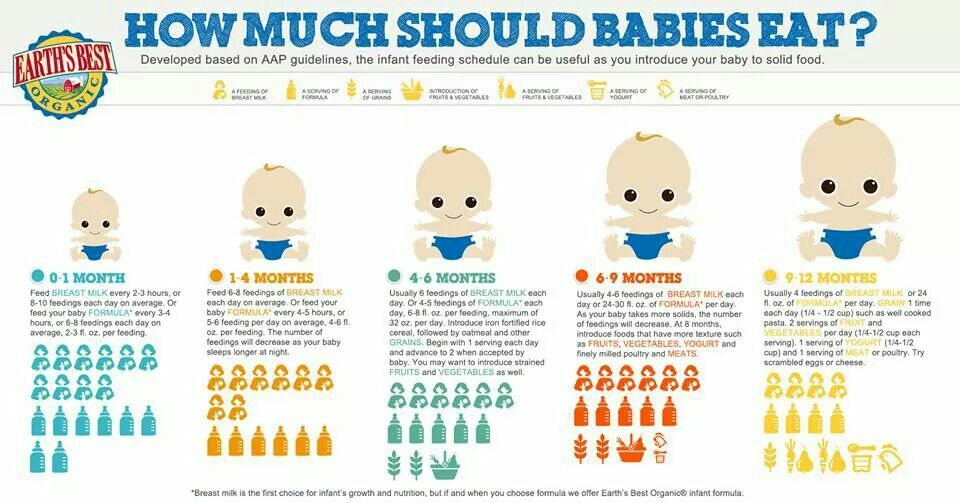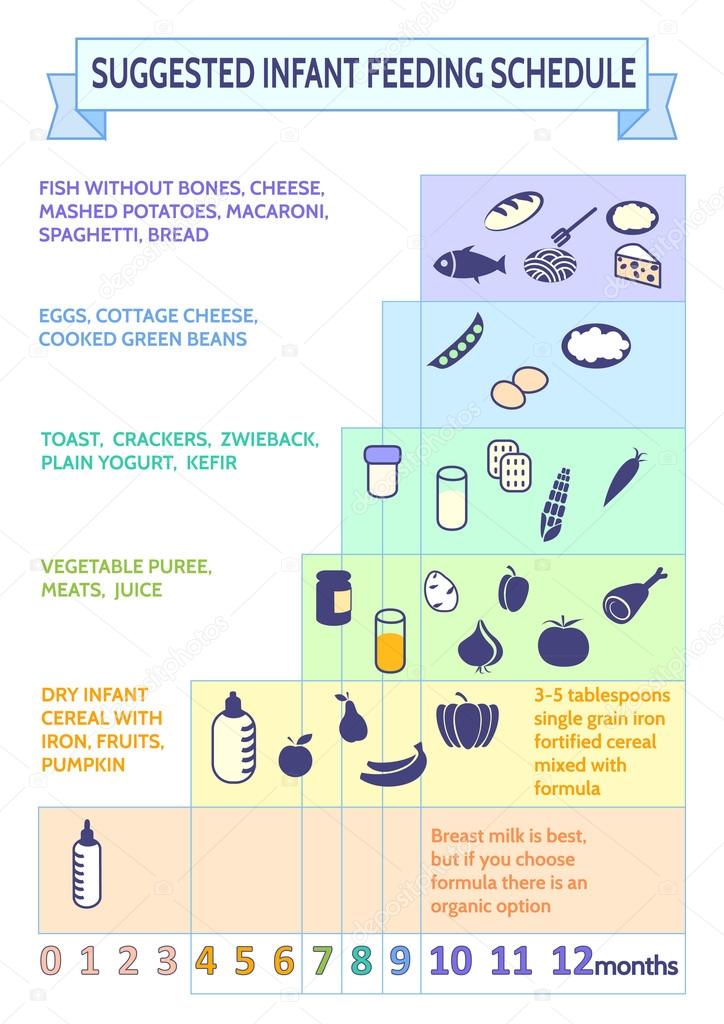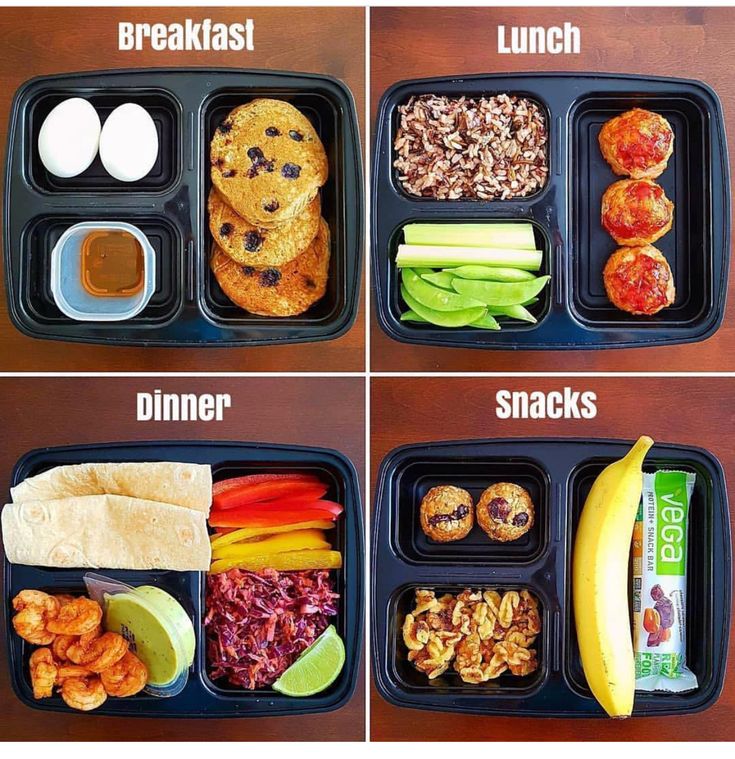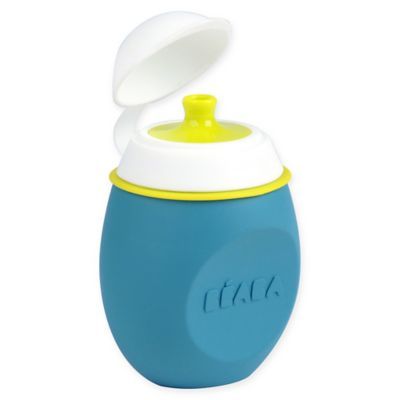Infant baby food guide
When, What, and How to Introduce Solid Foods | Nutrition
For more information about how to know if your baby is ready to starting eating foods, what first foods to offer, and what to expect, watch these videos from 1,000 Days.
The Dietary Guidelines for Americans and the American Academy of Pediatrics recommend children be introduced to foods other than breast milk or infant formula when they are about 6 months old. Introducing foods before 4 months old is not recommended. Every child is different. How do you know if your child is ready for foods other than breast milk or infant formula? You can look for these signs that your child is developmentally ready.
Your child:
- Sits up alone or with support.
- Is able to control head and neck.
- Opens the mouth when food is offered.
- Swallows food rather than pushes it back out onto the chin.
- Brings objects to the mouth.
- Tries to grasp small objects, such as toys or food.
- Transfers food from the front to the back of the tongue to swallow.
What Foods Should I Introduce to My Child First?
The American Academy of Pediatrics says that for most children, you do not need to give foods in a certain order. Your child can begin eating solid foods at about 6 months old. By the time he or she is 7 or 8 months old, your child can eat a variety of foods from different food groups. These foods include infant cereals, meat or other proteins, fruits, vegetables, grains, yogurts and cheeses, and more.
If your child is eating infant cereals, it is important to offer a variety of fortifiedalert icon infant cereals such as oat, barley, and multi-grain instead of only rice cereal. Only providing infant rice cereal is not recommended by the Food and Drug Administration because there is a risk for children to be exposed to arsenic. Visit the U.S. Food & Drug Administrationexternal icon to learn more.
How Should I Introduce My Child to Foods?
Your child needs certain vitamins and minerals to grow healthy and strong.
Now that your child is starting to eat food, be sure to choose foods that give your child all the vitamins and minerals they need.
Click here to learn more about some of these vitamins & minerals.
Let your child try one single-ingredient food at a time at first. This helps you see if your child has any problems with that food, such as food allergies. Wait 3 to 5 days between each new food. Before you know it, your child will be on his or her way to eating and enjoying lots of new foods.
Introduce potentially allergenic foods when other foods are introduced.
Potentially allergenic foods include cow’s milk products, eggs, fish, shellfish, tree nuts, peanuts, wheat, soy, and sesame. Drinking cow’s milk or fortified soy beverages is not recommended until your child is older than 12 months, but other cow’s milk products, such as yogurt, can be introduced before 12 months. If your child has severe eczema and/or egg allergy, talk with your child’s doctor or nurse about when and how to safely introduce foods with peanuts.
How Should I Prepare Food for My Child to Eat?
At first, it’s easier for your child to eat foods that are mashed, pureed, or strained and very smooth in texture. It can take time for your child to adjust to new food textures. Your child might cough, gag, or spit up. As your baby’s oral skills develop, thicker and lumpier foods can be introduced.
Some foods are potential choking hazards, so it is important to feed your child foods that are the right texture for his or her development. To help prevent choking, prepare foods that can be easily dissolved with saliva and do not require chewing. Feed small portions and encourage your baby to eat slowly. Always watch your child while he or she is eating.
Here are some tips for preparing foods:
- Mix cereals and mashed cooked grains with breast milk, formula, or water to make it smooth and easy for your baby to swallow.
- Mash or puree vegetables, fruits and other foods until they are smooth.

- Hard fruits and vegetables, like apples and carrots, usually need to be cooked so they can be easily mashed or pureed.
- Cook food until it is soft enough to easily mash with a fork.
- Remove all fat, skin, and bones from poultry, meat, and fish, before cooking.
- Remove seeds and hard pits from fruit, and then cut the fruit into small pieces.
- Cut soft food into small pieces or thin slices.
- Cut cylindrical foods like hot dogs, sausage and string cheese into short thin strips instead of round pieces that could get stuck in the airway.
- Cut small spherical foods like grapes, cherries, berries and tomatoes into small pieces.
- Cook and finely grind or mash whole-grain kernels of wheat, barley, rice, and other grains.
Learn more about potential choking hazards and how to prevent your child from choking.
Top of Page
Helpful Resources | Nutrition | CDC
If you would like more information on topics related to feeding your baby or toddler, here are some resources:
General
CDC’s Infant and Toddler Nutrition microsite syndication
CDC offers a free Web Content Syndication service that gives public health partners the opportunity to syndicate CDC content directly to their sites without having to monitor or copy updates. To search the CDC infant and toddler nutrition website available for syndication as well as other resources you can share, visit the CDC Public Health Media Library and browse or search for “infant and toddler nutrition”. Learn more about content syndication and how to add CDC syndicated content on your site.
To search the CDC infant and toddler nutrition website available for syndication as well as other resources you can share, visit the CDC Public Health Media Library and browse or search for “infant and toddler nutrition”. Learn more about content syndication and how to add CDC syndicated content on your site.
CDC’s Child and Teen Resources
This collection of resources provides parents and caregivers, health care providers, and partners with tools and information to help children and teens maintain a healthy weight and prevent obesity.
CDC’s Child Development Positive Parenting Tips (Infants)
This CDC website provides information about infants’ development, as well as tips for positive parenting and promoting the safety and health of infants.
CDC’s Learn the Signs. Act Early.
This website includes tools to track children’s milestones and resources about children’s development.
CDC’s Parent Information
This CDC website provides resources and information on pregnancy, infants and toddlers, children, and teens. Learn how to handle common parenting challenges through interactive activities, videos, and more. Healthcare professionals and researchers can also find information on children’s health and safety.
Learn how to handle common parenting challenges through interactive activities, videos, and more. Healthcare professionals and researchers can also find information on children’s health and safety.
CDC’s Division of Oral Health
Tooth decay (cavities) is one of the most common chronic diseases of childhood in the United States. Untreated tooth decay can cause pain and infections that may lead to problems with eating, speaking, playing, and learning. CDC’s Division of Oral Health provides information on what parents and caregivers can do to ensure good oral health for your child.
Dietary Guidelines for Americans 2020–2025 pdf icon[PDF-30.6MB]external icon
These guidelines provide science-based advice for Americans on what to eat and drink to promote health, reduce chronic disease, and meet nutrient needs. The 2020–2025 edition provides recommendations for all life stages, including infants and toddlers.
Feeding Guidelines for Infants and Young Toddlers: A Responsive Parenting Approachexternal icon
This report presents recommendations for promoting healthy nutrition and feeding patterns for infants and toddlers from birth to 24 months, with an emphasis on dietary quality, portion sizes, and mealtime environment.
Healthy Childrenexternal icon
This website was developed by the American Academy of Pediatrics for parents. It features thousands of articles in English and Spanish on children’s health and safety, as well as interactive tools.
United States Department of Agriculture Special Supplemental Nutrition Program for Women, Infants, and Children (WIC)external icon
The WIC Program provides support to low-income pregnant, postpartum, and breastfeeding women, babies, and children up to age 5. WIC provides nutritious foods, information on healthy eating, breastfeeding promotion and support, and referrals to health care.
United States Department of Agriculture Supplemental Nutrition Assistance Program (SNAP)external icon
SNAP provides benefits to low-income individuals and families and provides economic benefits to communities.
Feeding and Beverage Recommendationsexternal icon
Healthy Eating Research, a national program of the Robert Wood Johnson Foundation, offers science-based recommendations for parents and caregivers.![]() Tips are available for feeding children from birth through 24 monthsexternal icon and beverages for children from birth through 5 yearsexternal icon. Tips for older children are also available.
Tips are available for feeding children from birth through 24 monthsexternal icon and beverages for children from birth through 5 yearsexternal icon. Tips for older children are also available.
U.S. Food and Drug Administration (FDA) and Environmental Protection Agency’s (EPA) Advice About Eating Fishexternal icon
The U.S. FDA and EPA provide advice regarding eating fish. This advice can help people make informed choices when it comes to the types of fish that are nutritious and safe to eat. It is especially important for those who might become pregnant, who are pregnant, or who are breastfeeding, as well as for parents and caregivers who are feeding children. This advice supports the recommendations of the Dietary Guidelines for Americans.
Top of Page
Breastfeeding
CDC’s Breastfeeding Information
CDC’s Division of Nutrition, Physical Activity, and Obesity (DNPAO) is committed to increasing breastfeeding rates throughout the United States. CDC provides information for public health professionals and others to help support breastfeeding mothers, such as managing breastfeeding during various maternal and infant illnesses and conditions, any precautions for vaccines during breastfeeding, and recommendations for proper storage and handling of expressed human milk.
CDC provides information for public health professionals and others to help support breastfeeding mothers, such as managing breastfeeding during various maternal and infant illnesses and conditions, any precautions for vaccines during breastfeeding, and recommendations for proper storage and handling of expressed human milk.
International Lactation Consultant Association (ILCA)external icon
ILCA is the member association for professionals who care for breastfeeding families. ILCA’s “Find a Lactation Consultant Directory” can help you find a lactation consultant to get the breastfeeding support you need.
United States Lactation Consultant Association (USLCA)external icon
USLCA is a professional association for International Board Certified Lactation Consultants (IBCLCs) and other health care professionals who care for breastfeeding families. USLCA’s “Find an IBCLC” can help you find a lactation consultant to get the breastfeeding support you need.
WIC, the Special Supplemental Nutrition Program for Women, Infants, and Children—Breastfeeding Support external icon
The United States Department of Agriculture Special Supplemental Nutrition Program for Women, Infants, and Children (WIC) Breastfeeding Support website includes resources for expectant and current mothers about breastfeeding, overcoming common challenges, and thriving to make breastfeeding work for their families.
La Leche League USAexternal icon
La Leche League USA helps mothers to breastfeed through mother-to-mother support, encouragement, information, and education and promotes a better understanding of breastfeeding as an important element in the healthy development of the baby and mother.
Office on Women’s Healthexternal icon
The Office on Women’s Health’s vision is for all women and girls to achieve the best possible health outcomes. They provide information on breastfeeding to help women make infant feeding decisions and to guide mothers through the breastfeeding process.
Top of Page
Infant Formula
Questions & Answers for Consumers Concerning Infant Formulaexternal icon
The U.S. Food & Drug Administration regulates infant formula and has a list of questions and answers about infant formula.
Infant Formula Do’s and Don’tsexternal icon
The U.S. Food and Drug Administration provides information on infant formula preparation and storage, as well as other tips on how to keep infant formula safe.
Top of Page
Food Safety
Food Safety Concerns for Children Under Fiveexternal icon
Food safety is particularly important for young children. Foodsafety.gov provides information on safely preparing food for your child.
Top of Page
Meal Time
Fruits & Veggies—Have a Plant Movementexternal icon
A resource designed to help spread the word about the health benefits of adding more fruits and veggies to your diet.
USDA MyPlate Kitchenexternal icon
This online tool features a large collection of recipes and resources to support building healthy and budget-friendly meals. Site features include:
- Extensive search filters on cuisine, cooking equipment, nutrition content, and more.
- Detailed nutrition information.
- Cookbooks to browse and download or build your own.
- Recipe star ratings, review comments, and sharing on social networks.
Video Series on How to Introduce Solid Foods
1,000 Days has developed helpful videos about introducing solid foods to your baby. Topics include:
Topics include:
- Is your baby ready to start eating foods?
- What is a good first food for your baby?
- What to expect when introducing first foods
- How much should I feed my baby?
- How to win at mealtimeexternal icon
- What foods should my baby avoid?
- What should your baby eat in the first year?
Top of Page
Vitamins and Minerals
Vitamin and Mineral Fact Sheetsexternal icon
The National Institutes of Health’s Office of Dietary Supplements has fact sheets for consumers and health professionals about vitamins, minerals, and dietary supplements.
Top of Page
Medlib | MedLib.ru — Electronic Library
- Authors
- Recommended books
Viktor Tutelyan
Doctor of Medical Sciences, Professor, Academician of the Russian Academy of Sciences, Honored Worker of Science of Russia
Area of scientific interests:
food hygiene problems in connection with the consequences of the accident at the Chernobyl nuclear power plant, sanitary toxicology
Igor Yakovlevich Kon
Doctor of Medical Sciences, Professor, Honored Worker of Science of the Russian Federation, Academician of the Russian Academy of Natural Sciences
Area of scientific interests:
rational nutrition
Outpatient pediatrics Tutorial. 2nd edition, revised and enlarged
2nd edition, revised and enlarged
- Doskin V.A.
Year of publication: 2015 I.Ya.
Year of publication: 2015
Childhood diseases
Obstetrics and gynecology
Reading account required
Diseases of the digestive system in children with helicobacteriosis
- Shcherbakov P.L.
- Korsunsky A.A.
- Isakov V.A.
Year of publication: 2011
Gastroenterology and hepatology
Childhood diseases
Reading account required
Baby food Guide for doctors
- Tutelyan V.
 A.
A. - Horse I.Ya.
Year of publication: 2009
Childhood diseases
Reading account required
Clinical pharmacology of vasoactive agents and pharmacotherapy of cerebrovascular disorders Guide for doctors
- V.N.
Year of publication: 2009
Neurology and neurosurgery
Pharmacology, clinical pharmacology and pharmacotherapy
Reading account required
Pediatrics according to Nelson: in 5 vols. V. 3 Per. from English.
- Berman E.R.
Year of publication: 2009
Childhood illnesses
This book is not available for reading
Pediatrics according to Nelson: in 5 volumes, v. 4 Per. from English.
4 Per. from English.
- Berman E.R.
Year of publication: 2009
Childhood diseases
This book is not available for reading
Outpatient pediatrics
Year of publication: 2008
Textbooks and teaching aids
Childhood diseases
This book is not available for reading
Adolescent gastroenterology
- Filimonov R.M.
Year of publication: 2008
Gastroenterology and hepatology
Children's diseases
Needed for reading account
 Ya.
Ya. Year of publication: 2004
Childhood illnesses
This book is not available for reading
Baby food 📚 - the top of the best literature on the topic
Baby food 📚 - the top of the best literature on the topic | Read and listen online on MyBookChoice
Library
Subscription
📖Books
🎧Audiobooks
👌Free books
Carlos Gonzalez
Premium
This is not a guide to getting your child to eat more. The central idea of this book is not to force a child to eat, never, for any reason and under no circumstances. Dr. Gonzalez, an experienced pediatrician and father of three, shows through rigorous scientific evidence that our ...
The Gift of a Lifetime
Carlos Gonzalez
Premium
This book is a complete and comprehensive guide to help those women who want to breastfeed their baby. It covers in detail many topics related to breastfeeding, from the anatomy and physiology of the female breast to the growth and weight of the infant, from the technique of attachment to the breast to frequent...
It covers in detail many topics related to breastfeeding, from the anatomy and physiology of the female breast to the growth and weight of the infant, from the technique of attachment to the breast to frequent...
First soup, then dessert
Maria Kardakova
Premium
Maria Kardakova, a nutritionist and mother of two, provides helpful, relevant, and scientifically based advice on healthy diets for children from birth to adolescence. You will learn what factors influence your child's food preferences, how to determine whether he is getting enough...
Cooking for the little ones. Baby food from birth to school
Irina Pigulevskaya
Standard
A huge number of recipes and recommendations for the nutrition of children from birth to adolescence awaits you on the pages of the book. The author tells all about the features of feeding children. From the first part of the book, you will learn everything about the main varieties of complementary foods necessary for a full-fledged, bal. ..
..
Baby food. Various menus for every day from birth to five years
Tatyana Borisova
Premium
This book is popularly told about the modern medical basics of baby food from birth to five years. Much attention is paid to the first year of a child's life: mixed and artificial feeding, as well as feeding premature babies. Recommendations were given to the o...
Recipes for children over one year old
Unidentified author
Standard
Child nutrition is a very important family issue. After all, mistakes made in this area can lead to a delay in the physical and mental development of children, to serious metabolic disorders. And it is necessary to take care of high-quality and varied nutrition from the first days of a baby's life. This book will help...
Multicooker for babies. 1000 best recipes
Unidentified author
Standard
A slow cooker is a very necessary thing, but every mother has a question: is it possible to cook food for little gourmets in it? Yes, you certainly may! Moreover, you can simultaneously cook "duet dishes": one for adults, the other for kids. The capabilities of the multicooker allow you to use it in cooking...
The capabilities of the multicooker allow you to use it in cooking...
My child eats by himself. Complementary foods with pleasure
Polina Kazimirova
Premium
It's time to introduce complementary foods to your child, and you are terrified that you will become a hostage to cereals and purees for a long time? Taught by bitter experience with the elder, have firmly decided not to arrange theatrical performances in order to feed the younger? Or are you looking forward to complementary foods in the hope that your baby will become like this ...
Multicooker. Meals for children from 0 to 7 years old
Unidentified author
Standard
This book contains recipes for a children's menu that can be cooked in a slow cooker. Dairy dishes and homemade products, mashed soups, meat and fish steam dishes are suitable for kids. For older children, according to the proposed recipes, you can cook the first and second .











